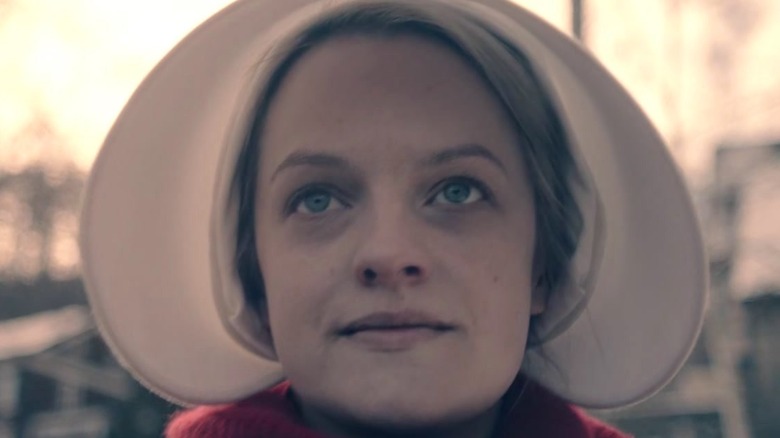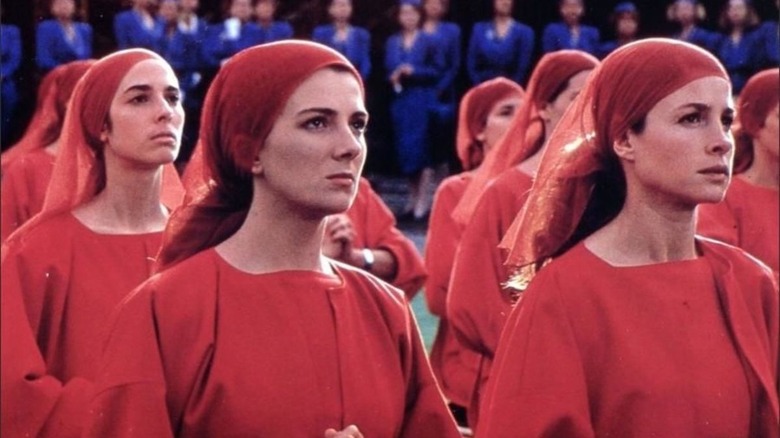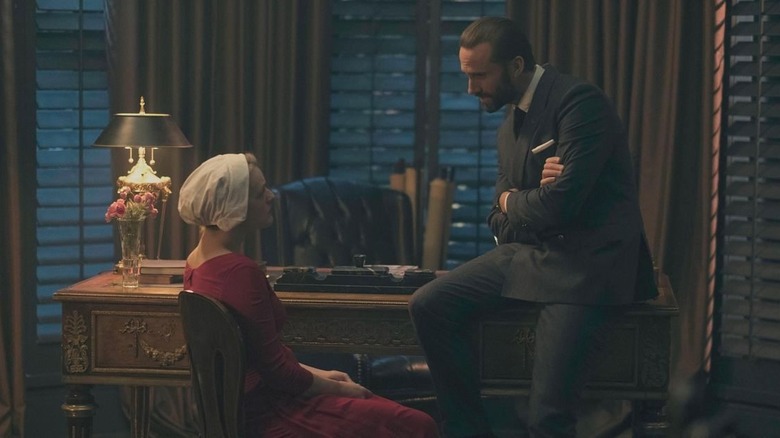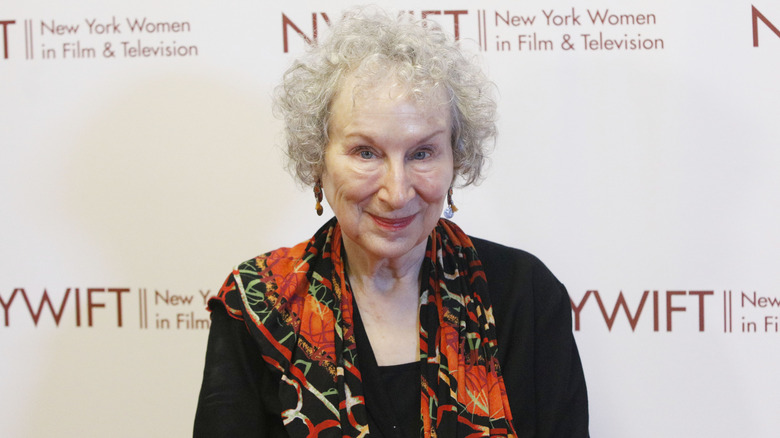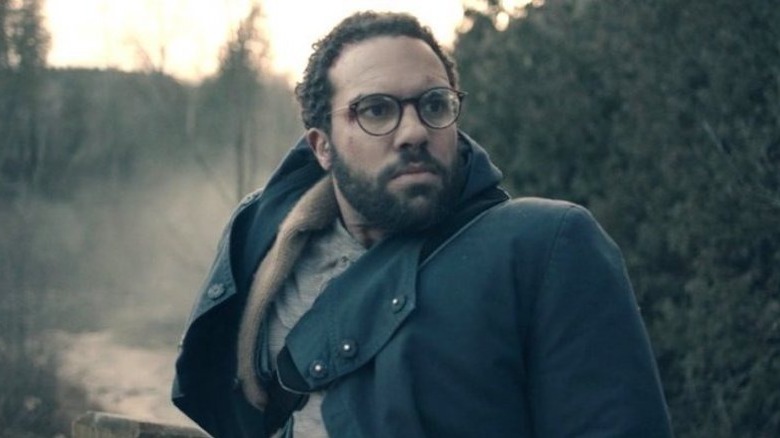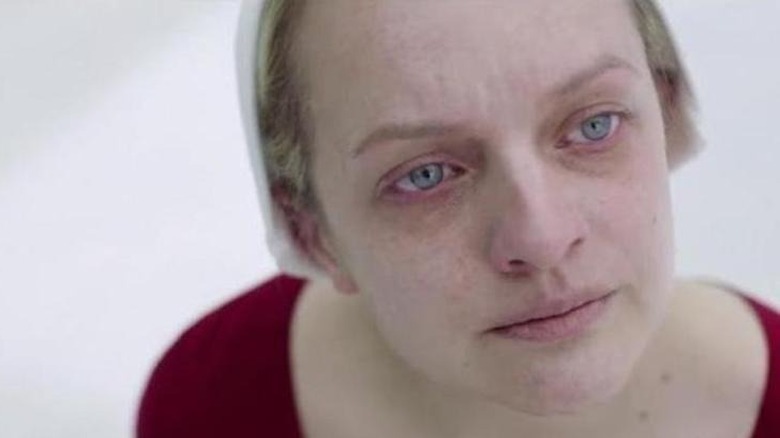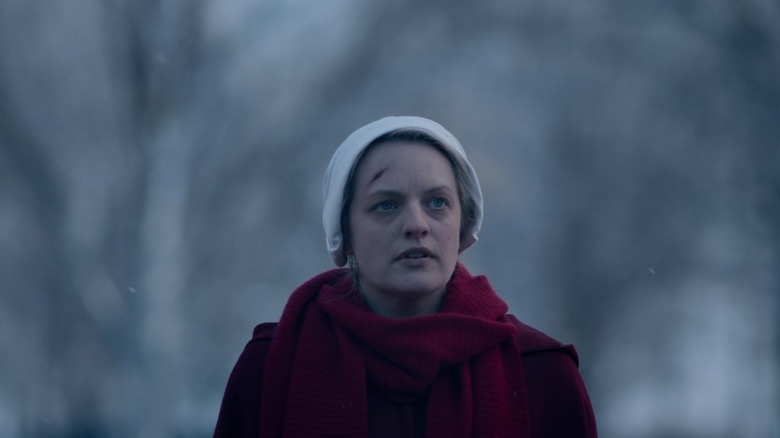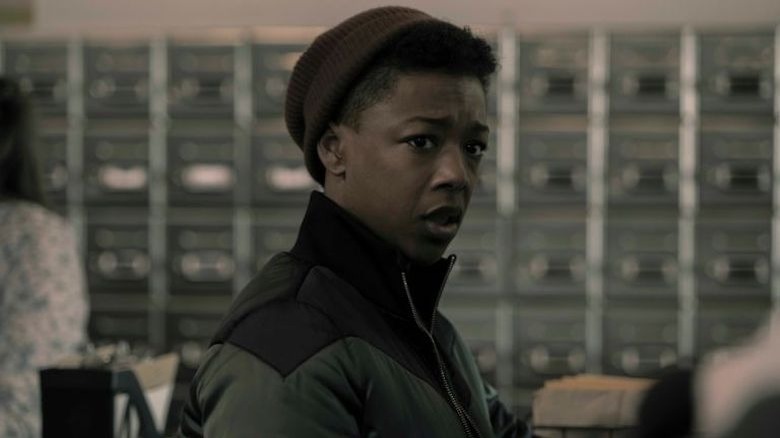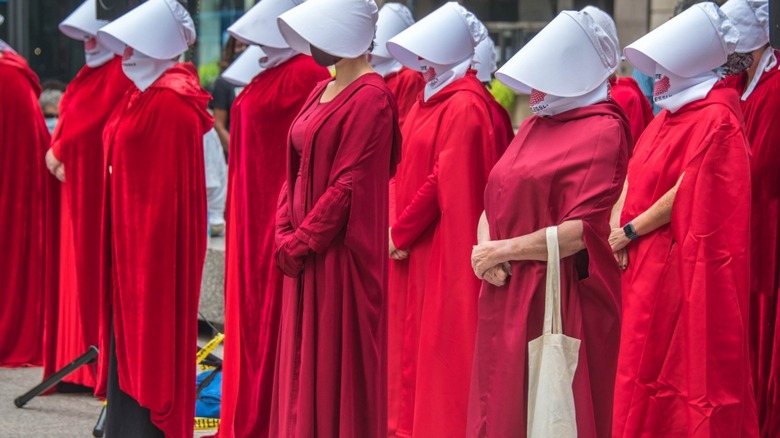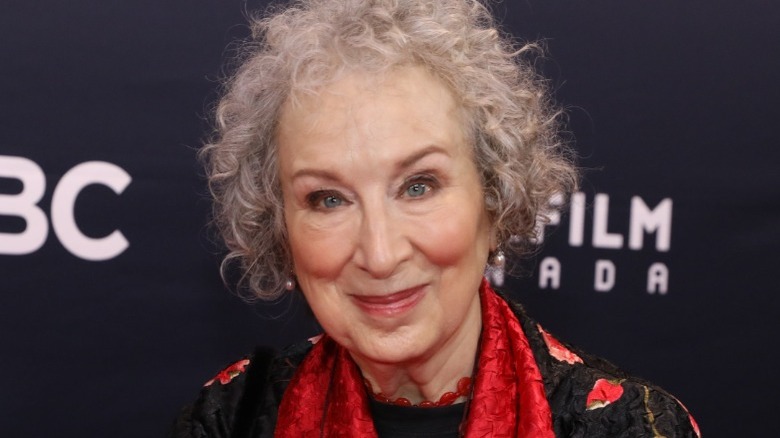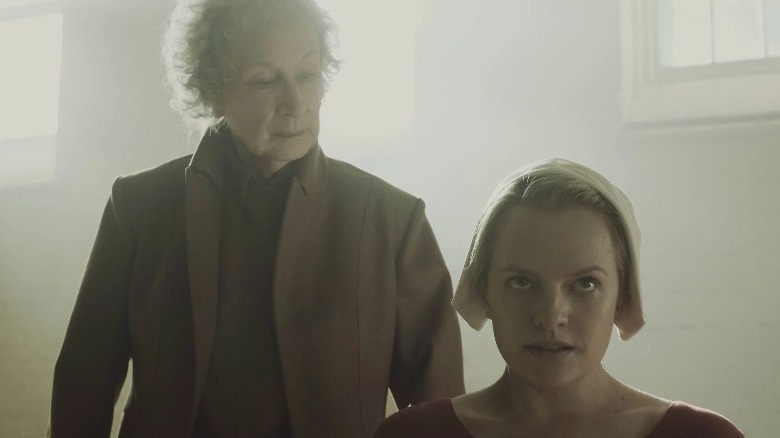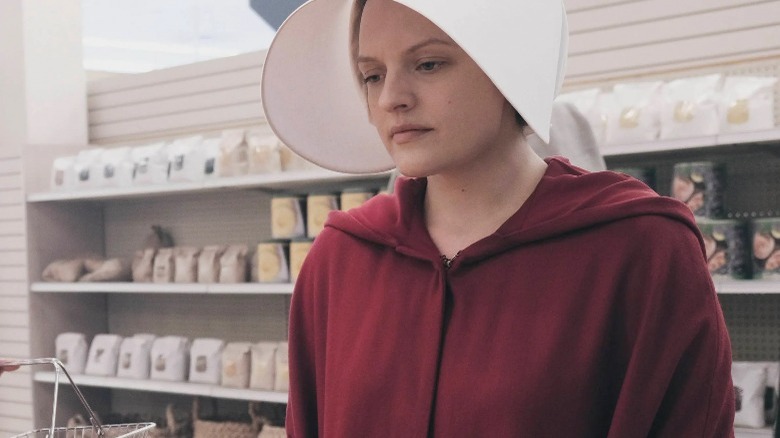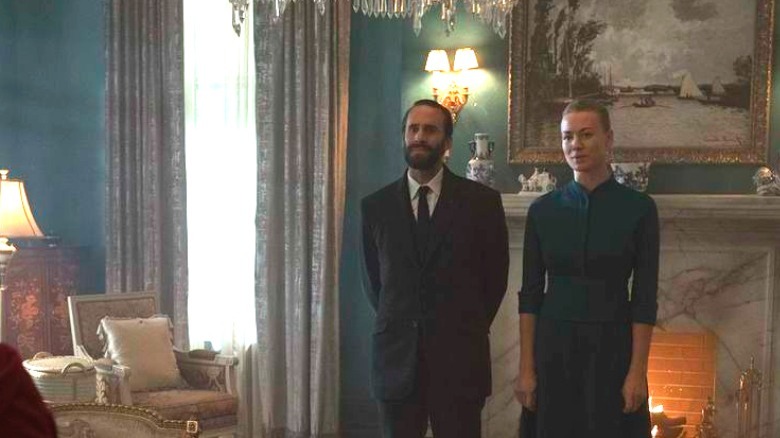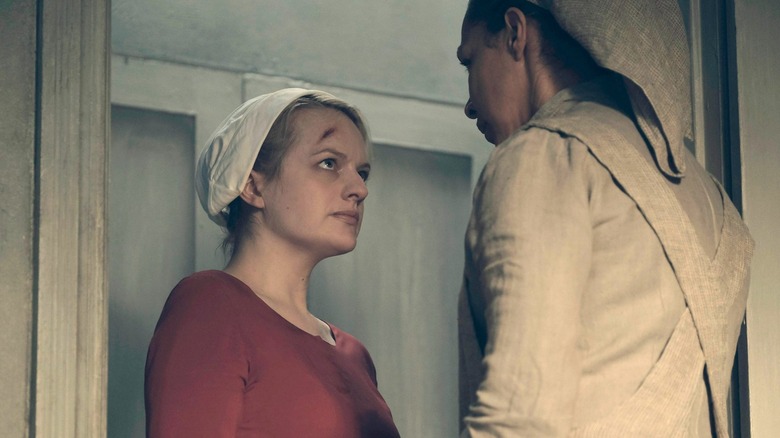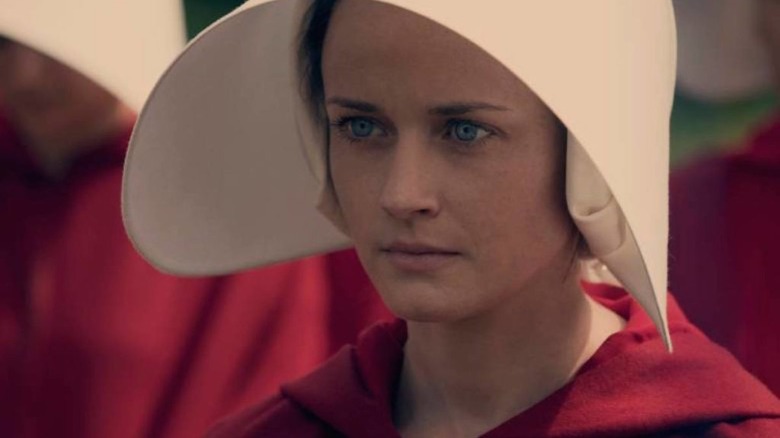The Untold Truth Of The Handmaid's Tale
In 1985, Margaret Atwood released her dystopian novel "The Handmaid's Tale," about a near-future society in which a patriarchal and totalitarian group has overthrown the U.S. government and created a new nation called Gilead. More than 30 years later, the story was adapted for television; the series, also titled "The Handmaid's Tale" premiered on Hulu on April 26, 2017 and became an instant sensation.
The story centers on a handmaid, June (Elisabeth Moss), known in Gilead only as Offred — referring to "Of Fred," as she is technically owned by her commander, Fred Waterford. Gilead took over the U.S. in the midst of an infertility epidemic, when it was becoming more and more rare for women to carry their pregnancies to term. With the creation of Gilead, those who had recently proved themselves fertile — June had a child with her husband, Luke (O. T. Fagbenle) a few years prior — are forced to become handmaids. As the assigned handmaid for the Waterford couple, June is forced to have sex with the Commander in order to conceive and give birth to a child for the couple.
"The Handmaid's Tale" was extremely well received upon its release, garnering multiple award nominations and wins. Along with critical acclaim, the series has pulled in a massive audience, which has remained consistent throughout its run. It was even renewed for a fifth season before the fourth had premiered (via Deadline).
The series has a lot of fans, but even the die-hards may not know all the background information about the dystopian drama. For those who are curious, here is the untold truth of "The Handmaid's Tale."
Creator Bruce Miller was drawn to the story for decades
The series creator Bruce Miller is no stranger to writing for television — he's worked on a slew of popular TV shows such as "ER," "Everwood" and "The 100" — but "The Handmaid's Tale" was the first show he created. As it turns out, Miller had been imagining this story on screen long before he was able to make it a reality.
In an interview with The Dreamcage promoting the show's first season, Miller explained that he was assigned the book in college for a "new fiction'" class and fell for it. "I loved the story. I was always a big fan of books that built the post-apocalyptic world. After school, I read it a couple of times over the years. Margaret Atwood was really one of the people that taught me how to write and how to think like a writer ... As my career moved into TV, I thought, 'Oh, this would make a great TV show.'"
Explaining that he was fascinated by the thought of diving into all the details and "hints" given in the book, Miller saw the larger surrounding world as ripe for exploration. But more than anything, he was attracted to the characters Atwood had created.
"It all goes back to the people who live in this world and how they survive and how they're trapped by their own choices," he said. "I wanted to tell the story about how these people lived through the experience and how they came out the other side alive and with some of their identity still intact. That was the thing I loved about the book, realizing by the end that Offred has kept herself alive."
The Handmaid's Tale has been adapted for screen before
Along with being adapted for the stage a handful of times (including at the Haymarket Theatre in the UK in 2002), "The Handmaid's Tale" was also adapted into a little-known film.
The film of the same name came out in 1990, directed by Volker Schlöndorff and starring Natasha Richardson as Offred (whose real name is Kate in this version), Faye Dunaway as Serena Joy, Robert Duvall as the Commander and Victoria Tennant as Aunt Lydia.
The film sticks to the events of the book fairly closely (the last act plays out a bit differently), much like the first season of the series does. But, unlike the series, the film was not well received — it has just a 32% Tomatometer on Rotten Tomatoes (in comparison, the series as a whole has an 83%, with the first season alone having a 94% score).
In a retrospective look back at the film (right around the time that the series was coming out), La Movie Boeuf summed up the consensus: "Schlondorff's treatment is idly drab and antiseptic, indifferent almost, as though he felt Atwood's vision was cinematic enough."
The set design is intricately detailed
The design team for "The Handmaid's Tale" doesn't let any space go to waste, making sure each room of the set is ripe with deeper meaning and messages. In a 2017 interview with Architectural Digest, production designer Julie Berghoff explained some of the meanings behind their set designs.
For example, the Commander's office, which Offred begins frequently visiting in Season 1, is filled with things that are off limits to women: books, art, alcohol, works containing sexual content. In a similar vein, Offred's bedroom is also a reminder of the things she can't have — specifically, how her former life has been taken away from her.
Berghoff explains, "We put a desk there, but she can't write. So it's almost like a remnant, a remembrance of 'Oh, I was a writer, an editor. I can't even sit and write anymore ... They don't want you to be vain anymore, so we basically put the shape of a mirror on the wall to make it feel like at one point there was a mirror there."
The basis for Atwood's story isn't fiction
While Atwood's 1985 work is obviously a piece of fiction, many of the horrific details of the book are pulled from real-life examples of authoritarian treatment toward women. In a 2017 interview with The Guardian, Atwood said, "When it first came out it was viewed as being far-fetched. However, when I wrote it I was making sure I wasn't putting anything into it that human beings had not already done somewhere at some time."
Stylist recently published a highly-detailed article, delving into some of the historical terrors that Atwood pulled from. In reference to the enforced dress codes of the handmaids of Gilead, it reads, "Religious clothing can and still is forced upon women by authorities in other, more conservative, communities; the Amish, for example, insist that women wear long dresses made of dark fabrics, and head coverings every single day."
A more horrifying example is the enforced surrogacy for the sake of the most privileged getting to raise the children. The Stylist piece reads, "In Australia as recently as the '70s, indigenous children were lawfully stolen from their homes and placed in religious institutions or fostered out to white families. From the end of World War II up until the late '70s, similar programs were carried out in the USA and Canada ... let's not forget the Magdalene laundries in Ireland, which saw young girls punished for their "immorality" by being forced into slave-like conditions. The babies they bore were taken away from them and placed with adoptive families all over the world — with 2,000 alone being shipped across to the USA."
Those are just a couple examples — the complete list by Stylist is terrifyingly long.
The show attempted to make Gilead more diverse
In the novel, all people of color have been forced out of Gilead, leaving only white central characters. Similarly, there aren't any LGBTQ characters in Atwood's novel. Anyone who has seen the series knows this isn't the case for the television version — a change Miller found vital. As he told TIME Magazine in 2017: "What's the difference between making a TV show about racists and making a racist TV show where you don't hire any actors of color?"
Ironically, the ways in which the show deals with race is one of the biggest criticisms it faces. A 2017 Guardian article pointed out that what the handmaids go through is eerily similar to what Black women went through on a daily basis during slavery — yet that parallel is ignored in the show. "None of these details are the inventions of Atwood's imagination or embellishments from Miller's writer's room; this is what actually happened during 245 years of slavery in the US – albeit to black women rather than white ones," the article reads. "Isn't it odd, then, to neither openly acknowledge this history, nor grapple with its legacy on screen?"
Vulture also addressed this issue in 2017, writing, "The show doesn't end up considering the racial dynamics of June's family, or what it means to be a handmaid of color ... In reality, though, it's more concerned with the interiority of white women at the expense of people of color who recognize that Gilead isn't a possible horrifying future, but the reality of what America has always been."
Moss forgoes makeup for the role
Moss has garnered a ton of attention for her stunning performance as June, a role which requires many closeups on her face as she deals with hardship upon hardship. With each of these closeups, June's current emotion — whether it be sorrow, rage, or rarely joy — is crystal clear. What also becomes clear to viewers with these closeups is June's lack of makeup. Naturally, a handmaid wouldn't be allowed to wear it — as vanity is not an option for the handmaids.
A character not wearing makeup isn't new for film or television, but it is rare for the actor to not be wearing any makeup (minimal makeup is typically applied on the actor for filming purposes, even if to give the impression that no makeup is on the character). "The Handmaid's Tale" uses a much more natural approach and Moss forgoes makeup for most scenes. If makeup is applied, it's typically to make Moss look more tired.
As Moss told Yahoo! Style in 2017, "If you're not sleeping a lot because you're working your [butt] off and you get dark circles and bags under your eyes — the more you have, the better. You're supposed to look stressed. In fact, one night I got sleep. I came in and my makeup artist was like, 'Oh dear,' and was disappointed that I didn't have the dark circles under my eyes that we needed."
Moss memorized her voiceover dialogue
"The Handmaid's Tale" is a great example of how powerful voiceover can be when utilized well. With June's voiceover, the audience is given an essential look into who she is at her core, rather than the "identity" she is forced into as a handmaid. Discussing his surprise over how perfectly the voiceover worked for the scenes, Miller told Vulture in 2017, "We shot these bits of Lizzie just sitting in a room, quietly going through emotional phases, and when I watched it paired up with the voice-over, it worked perfectly. And I said, 'That's lucky!'"
Except, it wasn't luck — it turns out that Moss had memorized all of her voiceover dialogue so that she could run it through her head while filming the scenes that the voiceover would match up with. "Paragraphs and paragraphs and paragraphs of stuff that she memorized and walked through emotions while she was sitting there silently
Moss is a bit more modest about this feat. She told Vulture: "It's a part of the script. Why wouldn't I memorize it? How else am I supposed to know what I'm thinking? I'm sitting there for 30 seconds. I have to be thinking about something ... I just thought that was part of my job."
The 2016 election impacted the show
Upon its debut, many people viewed "The Handmaid's Tale" series as a response to the 2016 election, in which Donald Trump — an alleged rapist, amongst other things — was elected president. Not only has Trump been accused of rape and sexual assault — one of the many horrors the handsmaids must suffer through — but many of his supporters believe in things such as abortion and other means of controlling women's bodies, the inspiration of the "Handmaid's Tale" novel, show and film.
It's an intriguing connection, but also one that mostly is not true. The Hollywood Reporter pointed out in 2017 that much of the first season was completed before Trump was elected, making it "one of the most unintentionally relevant shows in recent years." When the cast and crew returned for a second season, however, the general atmosphere was much different on set, and those election results were undeniably on some minds as perceived similarities presented themselves in the daily headlines.
Samira Wiley, who plays Moira (another handmaid and close friend to June), spoke with Vanity Fair in 2017 about how the election impacted everyone. "Coming back to the show, it was. . . 'Oh my gosh, we have an even bigger responsibility now.' To have this show be excellent, have it have all the integrity it should have."
The Handmaid's Tale broke an Emmy record
At the 2017 Emmys, "The Handmaid's Tale" swept the night. Of their 13 nominations, the series won eight of those, including three acting categories (for Moss, Ann Dowd and Alexis Bledel), directing, writing and production design, amongst others. The series also won the coveted Outstanding Drama Series — often the last award presented.
With this win, the series became the first show from a streaming service to ever win the Outstanding Best Drama Emmy. With streaming services becoming more and more prominent — and continuing to produce award-worthy content — this record is one that could go down in the history books.
Backstage after the show's win, Miller said (via Deadline): "The way that Hulu handled our show, they were bold and behind us and really committed to making something interesting. If the streaming services continue to do that, I don't see a limit to how many [Emmys] they can win."
The Handmaid's Tale took inspiration from a Bible story
In "The Handmaid's Tale," Gilead supporters often twist biblical scripture to justify the injustices of their society — this is especially true of Gilead's treatment of the handmaids — and the justification of creating handmaids may find its basis in a story from the Old Testament. In Genesis 29, Jacob meets and immediately falls in love with Rachel, the daughter of Laban. Rachel's older sister Leah is single, and their father is eager to see her wed. Jacob promises Laban seven years of hard labor if, in the end, he can marry Rachel. Laban agrees, but secretly has other plans ... he tricks Jacob into sleeping with Leah and forces him to marry her. Ultimately, Jacob is allowed to marry Rachel as well, but as she is initially barren, Leah (who Jacob never loves) bears the first four of his 12 children.
The Rachel and Leah Center (also referred to as "The Red Center" by the women tragically forced to become handmaids) plays a significant role in "The Handmaid's Tale" — it's where fertile women are taken and trained to become handmaids for the infertile wives of Gilead commanders. According to the series' fandom site, the handmaids were inspired by the biblical story for which the center is named.
Atwood dedicated her book to an accused 17th century witch
Margaret Atwood cites the pre-Salem, Hadley, Massachusetts witch trial of Mary Webster as inspiration for "The Handmaid's Tale" — she even included Webster's name on the book's dedication page. Atwood spoke about Webster on the Studio 360 podcast and said, "'The Handmaid's Tale' is dedicated to Mary Webster because she is a female person wrongly accused."
According to the New England Historical Society, in 1683, Mary Webster was tried for witchcraft due only to her abject poverty and abrasive persona. Webster was one of the few accused of witchery to be acquitted by a jury, as the mass hysteria and inundation of the trials was still almost a decade away. However, Webster's neighbors decided she was, indeed, a witch when a prominent male citizen in her town died under mysterious circumstances ... so they tried to hang her from a tree. The next day, the tree branch broke, and Webster survived.
In "The Handmaid's Tale," many women face punishment for perceived crimes they didn't commit. For example, in Season 2, Eden (Sydney Sweeney), the teenage wife of Nick Blaine (Max Minghella), secretly begins seeing the more age-appropriate Issac (Rohan Mead). The couple attempts to escape Gilead together, but are caught by Gildeadean forces. Both are sentenced to death by drowning. This is just one example of many of an unjust fate suffered by a woman who doesn't "stay in line." Webster would also become the focus of Atwood's poem, Half-Hanged Mary.
Elisabeth Moss directed some of the show's episodes
On each season of "The Handmaid's Tale," Elisabeth Moss turns in a riveting, emotionally resonant portrayal as the series' protagonist, June Osborne. But did you know she's also responsible for some of the epic storytelling behind the camera? Moss made her directorial debut on the series in Season 4, and directed three episodes, including the heart-rending installment "The Crossing." She also directed three episodes in Season 5, including the season's opener and the season finale. No small feat when you consider that "The Handmaid's Tale" centers on June's perspective, and Moss appears in every episode. The powerful gamut of emotions she displays through a simple facial expression takes a lot of work — imagine having the capacity to do as artfully as Moss does and direct the rest of the cast as well?
Moss sat down with The Playlist to discuss directing (per Entertainment Weekly, Moss also directed two episodes of the AppleTV+ thriller "Shining Girls," in which she also stars), and said, "I sometimes can't get over it, like I'm prepping the finale right now. I still pinch myself. I'm just like, I can't believe doing the finale of 'Handmaid's Tale', this is crazy! I'm truly honored to be in this position. I feel like it's a nice new challenge."
Margaret Atwood appears in the pilot episode
In a column for the New York Times about the parallels between the current political climate and Gilead in "The Handmaid's Tale," Margaret Atwood spoke about her cameo appearance in the show's pilot episode. "In this series I have a small cameo ... The Handmaids sit in a circle, with the Taser-equipped Aunts forcing them to join in what is now called (but was not, in 1984) the 'slut-shaming' of one of their number, Jeanine (sic), who is being made to recount how she was gang-raped as a teenager," she wrote. Atwood portrays a nameless Aunt who works with Aunt Lydia (Ann Dowd) at the Red Center — she even gets to smack Elisabeth Moss on the side of her head after June refuses to participate in the shaming of Janine (Madeline Brewer).
In an interview with the New York Times, Atwood described minor contentions she holds with the show. "I think it's a bit of a problem for people that know about real totalitarianism that some of these characters have survived for as long as they did. Surely they would have been shot by now. Quite a few too many people know what June has been up to," she said. After the series began, Atwood released her follow-up novel to "The Handmaid's Tale." Titled "The Testaments," Atwood's sequel is set 15 years after the events of the first book. The story is narrated, in part, by Aunt Lydia, who has survived in Atwood's world.
The handmaids' grocery store labels don't contain words
The crew on the set of "The Handmaid's Tale" has worked hard to make sure each intricate detail of set dressing is aligned with the world-building of the show. From the Red Center (a former school; females do not attend school in Gilead) to the grocery store product labels, every last set piece is designed to subtly adhere to the horrific mindset of Gilead. The show's production designer Julie Berghoff spoke to Architectural Digest about the designs, and said, "Everything was very purposeful," adding, "The grocery store was probably one of our hardest sets because we fabricated every single label there. My graphics team painstakingly designed hundreds and hundreds of labels and then applied them to certain things."
In Gilead, the handmaids do most of the grocery shopping for the households that claim ownership of them. Often, the store — Loaves and Fishes — is the only place where handmaids can speak to one another. Marthas, females forced to cook and serve Gileadean households, shop at Loaves and Fishes as well. In fact, many of the plans hatched by the Martha-led resistance group known as Mayday have their inception at Loaves and Fishes.
The store bears memories of the U.S. — the architecture and the cheerful lighting are modern American designs. However, astute viewers may notice that the products on the shelves are definitely Gileadean. The show's design team created product labels that reflect Gilead's prohibition of women readers; each label contains symbols only.
Stolen art adorns the Waterfords' walls
In her interview with Architectural Digest, Berghoff also spoke about the art in Fred and Serena Joy Waterford's home. "We pretended like they went into the Boston Museum of Modern Art and stole all their favorite paintings," she said. In the Waterfords' world of upper-echelon Gilead living, art is a rare treasure and reflects the wealth and prestige of its owner. Stolen art also harkens back to other terrifying periods in world history; for instance, the Nazis were known for their thievery of art masterpieces. According to the BBC, the Nazis stole pieces of art that were lost, and others which wound up in museums: After the war, very few works of art stolen by the Nazis were returned to their rightful owners.
The Commanders of Gilead (and their faithful wives) share many similarities with the Nazis — blaming entire swaths of innocent people for the infertility pandemic, trampling on the basic human rights of all women as well as those of men who stand against their totalitarian ideals, and essentially using genocidal means to rid themselves of those who stand in any level of opposition. As Cosmopolitan points out in a review of "The Handmaid's Tale" Season 3, when the Waterfords visit Washington, D.C. and contemplate a move, one of the homes offered still contains all of the belongings of residents who were killed or taken prisoner by Gilead officials. It makes sense that any decor in their current home was stolen too.
Atwood's novel ended with the Season 1 cliffhanger
Although each season of "The Handmaid's Tale" feels true to the spirit in which Margaret Atwood wrote her novel, the source material ends with the cliffhanger of Season 1. In Atwood's book, June's fate is left up to the reader. The story ends with June (who is only known as Offred in the book) being led away by the Eyes of God secret police, a Gestapo-like organization determined to eradicate any resistance to Gilead's mission — yet this could be a cover for the Mayday resistance members too.
In the novel, Atwood doesn't spell out June's fate. Per Elite Daily, when the "Eyes" van comes to take June away, Nick (who is the father of June's unborn baby) tells his secret lover to "Just go with them. Trust me." In terms of creating a world past the source material, showrunner Bruce Miller told the Washington Post, "The way we approached it was very much to try to make it still feel like the world Margaret Atwood created. A lot of times, you adapt a classic work and the author is unfortunately long gone, and Margaret's very much with us, so we got to pick her brain for what her thinking behind the story was."
Ofglen doesn't survive Gilead in the novel
Ahead of the Season 5 premiere of "The Handmaid's Tale," Alexis Bledel, who portrayed the vital character Emily/Ofglen, announced her departure from the show. As reported by Variety, Bledel released a statement on her exit that read, "After much thought, I felt I had to step away from 'The Handmaid's Tale' at this time. I am forever grateful to Bruce Miller for writing such truthful and resonant scenes for Emily, and to Hulu, MGM, the cast and crew for their support."
Although fans may have been disappointed, the show was quick to address Emily's absence in a way that made sense for the character. In the opening episode of Season 5, after Emily, June, and the other handmaids exact a violent revenge against Commander Waterford, June goes to visit Emily at her home. She's met at the door by Emily's wife Sylvia (Clea Duvall), who explains that Emily has gone back to Gilead to find Aunt Lydia and make her pay for the suffering she bestowed on the handmaids.
However disappointed fans may feel, the onscreen version of Ofglen lasted far longer than Margaret Atwood's original character. As noted by Insider, in the novel, Ofglen doesn't receive a backstory; she really isn't a fully fleshed out character. When Ofglen is taken to the Colonies (the radioactive, barren region where women "criminals" are sent as punishment), her replacement tells Offred that Ofglen hanged herself.
The Handmaid's Tale ends with Season 6
The first season of "The Handmaid's Tale" covers all of the events of the novel — so although Bruce Miller still consults the source material, the television series has developed much further. Delighted fans of the show grew excited when the show was able to execute powerful storylines that weren't explicitly in the book. Alas, all good things must come to an end, and "The Handmaid's Tale" wraps up its story with Season 6.
Earlier, Miller told The Hollywood Reporter, "I certainly don't [have a number of seasons in mind]. I always thought I did and that, I think, is a pandemic change. I thought I had a beginning, a middle and an end — and I still feel like I very much have an end — it's just that I'm finding more interesting paths along the way and more interesting things to do as we move towards more fascinating parts of the story." But before the Season 5 premiere, he announced the sixth season of the show would be its last.
Per Entertainment Weekly, Miller announced the show's end at the 2022 Toronto Film Festival. He spoke of the honor of bringing Atwood's novel to life, and said, "We are grateful to Hulu and MGM for allowing us to tell this story, which unfortunately has remained as relevant as ever throughout its run, and are in awe of our incredible fans for their unwavering support, and without whom we never would have gotten to this point."
